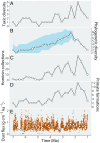Sporadic sampling, not climatic forcing, drives observed early hominin diversity
- PMID: 29686074
- PMCID: PMC5948983
- DOI: 10.1073/pnas.1721538115
Sporadic sampling, not climatic forcing, drives observed early hominin diversity
Abstract
The role of climate change in the origin and diversification of early hominins is hotly debated. Most accounts of early hominin evolution link observed fluctuations in species diversity to directional shifts in climate or periods of intense climatic instability. None of these hypotheses, however, have tested whether observed diversity patterns are distorted by variation in the quality of the hominin fossil record. Here, we present a detailed examination of early hominin diversity dynamics, including both taxic and phylogenetically corrected diversity estimates. Unlike past studies, we compare these estimates to sampling metrics for rock availability (hominin-, primate-, and mammal-bearing formations) and collection effort, to assess the geological and anthropogenic controls on the sampling of the early hominin fossil record. Taxic diversity, primate-bearing formations, and collection effort show strong positive correlations, demonstrating that observed patterns of early hominin taxic diversity can be explained by temporal heterogeneity in fossil sampling rather than genuine evolutionary processes. Peak taxic diversity at 1.9 million years ago (Ma) is a sampling artifact, reflecting merely maximal rock availability and collection effort. In contrast, phylogenetic diversity estimates imply peak diversity at 2.4 Ma and show little relation to sampling metrics. We find that apparent relationships between early hominin diversity and indicators of climatic instability are, in fact, driven largely by variation in suitable rock exposure and collection effort. Our results suggest that significant improvements in the quality of the fossil record are required before the role of climate in hominin evolution can be reliably determined.
Keywords: Africa; climate; early hominin diversity; fossil record quality; sampling bias.
Copyright © 2018 the Author(s). Published by PNAS.
Conflict of interest statement
The authors declare no conflict of interest.
Figures


Similar articles
-
Hominin taxic diversity: Fact or fantasy?Am J Phys Anthropol. 2016 Jan;159(Suppl 61):S37-78. doi: 10.1002/ajpa.22902. Am J Phys Anthropol. 2016. PMID: 26808110
-
Relevance of the eastern African coastal forest for early hominin biogeography.J Hum Evol. 2019 Jun;131:176-202. doi: 10.1016/j.jhevol.2019.03.012. Epub 2019 Apr 17. J Hum Evol. 2019. PMID: 31182201
-
Correlates and catalysts of hominin evolution in Africa.Theory Biosci. 2017 Dec;136(3-4):123-140. doi: 10.1007/s12064-017-0250-5. Epub 2017 Jun 9. Theory Biosci. 2017. PMID: 28597395
-
The Omo-Turkana Basin fossil hominins and their contribution to our understanding of human evolution in Africa.Evol Anthropol. 2011 Nov-Dec;20(6):264-92. doi: 10.1002/evan.20335. Evol Anthropol. 2011. PMID: 22170695 Review.
-
The hominin fossil record: taxa, grades and clades.J Anat. 2008 Apr;212(4):354-76. doi: 10.1111/j.1469-7580.2008.00871.x. J Anat. 2008. PMID: 18380861 Free PMC article. Review.
Cited by
-
Different environmental variables predict body and brain size evolution in Homo.Nat Commun. 2021 Jul 8;12(1):4116. doi: 10.1038/s41467-021-24290-7. Nat Commun. 2021. PMID: 34238930 Free PMC article.
-
Plio-Pleistocene environmental variability in Africa and its implications for mammalian evolution.Proc Natl Acad Sci U S A. 2022 Apr 19;119(16):e2107393119. doi: 10.1073/pnas.2107393119. Epub 2022 Apr 11. Proc Natl Acad Sci U S A. 2022. PMID: 35412903 Free PMC article.
-
Early Pleistocene faunivorous hominins were not kleptoparasitic, and this impacted the evolution of human anatomy and socio-ecology.Sci Rep. 2021 Aug 9;11(1):16135. doi: 10.1038/s41598-021-94783-4. Sci Rep. 2021. PMID: 34373471 Free PMC article.
-
Mid-Pleistocene aridity and landscape shifts promoted Palearctic hominin dispersals.Nat Commun. 2024 Nov 27;15(1):10279. doi: 10.1038/s41467-024-54767-0. Nat Commun. 2024. PMID: 39604451 Free PMC article.
-
Diversity-dependent speciation and extinction in hominins.Nat Ecol Evol. 2024 Jun;8(6):1180-1190. doi: 10.1038/s41559-024-02390-z. Epub 2024 Apr 17. Nat Ecol Evol. 2024. PMID: 38632435 Free PMC article.
References
-
- Darwin CR. On the Origin of Species by Means of Natural Selection. John Murray; London: 1859.
-
- Wood BA, Grabowski MW. Macroevolution in and around the hominin clade. In: Serrelli E, Gontier N, editors. Macroevolution: Explanation, Interpretation and Evidence. Springer; Cham, Switzerland: 2015. pp. 345–376.
-
- Vrba ES. The fossil record of African antelopes (Mammalia, Bovidae) in relation to human evolution and paleoclimate. In: Vrba ES, Denton GH, Partridge TC, Burckle LH, editors. Paleoclimate and Evolution, with Emphasis on Human Origins. Yale Univ Press; New Haven, CT: 1995. pp. 385–424.
-
- deMenocal PB. Plio-Pleistocene African climate. Science. 1995;270:53–59. - PubMed
Publication types
MeSH terms
Associated data
LinkOut - more resources
Full Text Sources
Other Literature Sources
Medical
Miscellaneous

